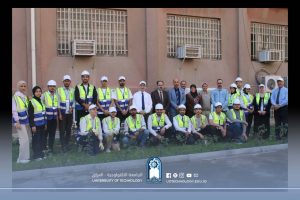
Scientific symposium on wastewater treatment using moving membrane technology
- Posted by Saif Bashar
- Categories News
- Date March 24, 2024
In line with the university’s orientation to achieve sustainable development goals, especially the sixth goal (Clean Water and Sanitation), the Environmental Research Center holds a scientific symposium on wastewater treatment using the MBBR movable membrane technology Under the patronage of the President of the University of Technology, Prof. Dr. Ahmed Mohammed Hassan Al-Ghaban, the Environmental Research Center at the university held a scientific symposium on the occasion of Earth Day entitled Wastewater Treatment Using the MBBR movable membrane technology, delivered by the Director of the Center, Prof. Dr. Zainab Baha Mohammed, in the presence of lecturers and members of the Center and the University.
She mentioned that recently, water resources in Iraq have witnessed a deterioration in terms of quantity and quality. In addition, the current central wastewater treatment plants are unable to meet the increasing demand due to the high population growth rate. She added that Halvard Odegaard is the name of the Norwegian professor who founded the biofilm reactor transfer technology. Bahaa touched on the definition of MBBR as a biofilm reactor to create a fixed shape where the biomass is created with a density slightly higher than water on small carrier components and the approach focuses on the carriers to which the biomass is attached and planted and the effect of the production of carrier materials, especially for wastewater plants that are heavily loaded on their size and shape. As for the benefits of MBBR, biofilm processes generally require less space than activated sludge systems because the biomass is more concentrated and the efficiency of the system is less dependent on the final separation of the sludge and MBBR systems do not need to recycle the sludge as is the case with activated sludge systems.
The MBBR system is often installed as an update to the existing activated sludge stocks to increase the capacity of the existing system and the degree of filling of the carriers can be adapted to the specific situation and the required capacity and thus the current treatment plant can be increased in capacity without increasing its capacity without increasing the space by building new tanks.



